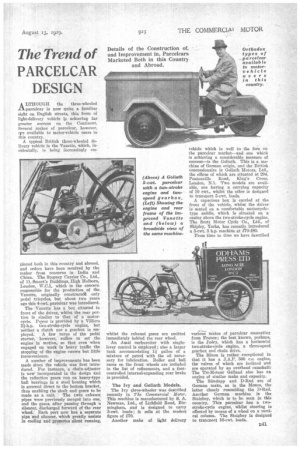The Trend of PARCELCAR DESIGN
Page 67

If you've noticed an error in this article please click here to report it so we can fix it.
ALTHOUGH the three-wheeled parcelcar is now quite a familiar sight on English streets, this form of light-delivery vehicle is achieving far greater success on the Continent. Several makes of parcelcar, however, tre available to motor-vehicle users in this country.
A typical British three-wheeled delivery vehicle is the Vanette, which, incidentally, is being increasingly ern ployed both in this country and abroad, and orders have been received by the maker from concerns in India and China. The Stepney Carder Co., Ltd., of 11, Smart's Buildings, High Holborn, London, W.C.1, which is the concern responsible for the production of the Vanette, originally constructeg only pedal tricycles, but about two years ago this 4-cwt. parcelcar was introduced.
The Vanette has a box situated in front of the driver, whilst the rear portion is similar to that of a motorcycle. Power is provided by a Villiers 21-h.p. two-stroke-cycle engine, but neither a clutch nor a gearbox is em
ployed. A few turns of the pedal starter, however, suffice to set the engine in motion, so that even when engaged on work in heavy traffic the stopping of the engine causes but little inconvenience.
A number of improvements has been made since the vehicle was first introduced. Por instance, a chain-adjuster is now incorporated in the design and the reduction gears run on heavy-type ball bearings in a steel housing which is screwed direct to the bottom bracket, thus enabling the shaft and gears to be made as a unit. The twin exhaust pipes were previously merged into one, and the gases, after passing through a silencer, discharged forward of the rear wheel. Each port now has it separate pipe and silencer, which greatly assists in cooling and promotes silent running, Details of the Construction of, and Improvement in, Parcelcars Marketed Both in this Country and Abroad.
whilst the exhaust gases are emitted immediately behind the rear wheel.
An Amal carburetter with singlelever control is employed ; also a larger tank accommodating 1.1 gallon of a mixture of petrol with the oil necessary for lubrication. Roller and ball races on the front wheels are included in the list of refinements, and a footcontrolled internal-expanding rear brake is provided.
The Ivy and Goliath Models.
The Ivy three-wheeler was described recently in The Commercial Motor. This machine is manufactured by S. A. Newman, Ltd., of Lichfield Road, Birmingham, and is designed to carry 3-cWt. loads ; it sells at the modest figure of £70.
Another make of light delivery
vehicle which is well to the fore on the parcelcar market—and one which is achieving a considerable measure of success—is the Goliath. This is a machine of German origin, and the British concessionaire is Goliath Motors, Ltd., the offices of which are situated at 294, Pentonville Road, King's Cross, London, N.1. Two models are available, one having a carrying capacity of 10 cwt., whilst the other is designed to transport 5-cwt. loads.
A capacious box is carried at the front of the vehicle, whilst the driver is seated on a comfortable motorcycletype saddle, which is situated on a casing above the two-stroke-cycle engine. The Scott Motor Cycle Co„ Ltd., of Shipley, Yorks, has recently introduced a 3-cwt. 3 h-p. machine at £70-£80.
From time to time we have described various makes of parcelcar emanating from France; the best known, perhaps, is the Ju6ry, which has a horizontal two-stroke-cycle engine, a three-speed gearbox and chain drive.
The Ninon is rather exceptional in that it has a J.A.P. 500 c.c. engine, the valves of which are inclined and are operated by an overhead camshaft. The Tri-Moteur Galland also has an engine of similar make and capacity.
The Ziindapp and 1)-Had are of German make, as is the Monos, the latter closely resembling the 1)-Red. Another German machine is the Steigboy, which is to be seen in this country. This parcelcar has a twostroke-cycle engine, whilst steering is effected by means of a wheel on a vertical column. The Steigboy is designed to transport 10-cwt. loads.




















































































































